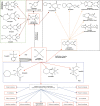Metal complexes in cancer therapy - an update from drug design perspective
- PMID: 28424538
- PMCID: PMC5344412
- DOI: 10.2147/DDDT.S119488
Metal complexes in cancer therapy - an update from drug design perspective
Abstract
In the past, metal-based compounds were widely used in the treatment of disease conditions, but the lack of clear distinction between the therapeutic and toxic doses was a major challenge. With the discovery of cisplatin by Barnett Rosenberg in 1960, a milestone in the history of metal-based compounds used in the treatment of cancers was witnessed. This forms the foundation for the modern era of the metal-based anticancer drugs. Platinum drugs, such as cisplatin, carboplatin and oxaliplatin, are the mainstay of the metal-based compounds in the treatment of cancer, but the delay in the therapeutic accomplishment of other metal-based compounds hampered the progress of research in this field. Recently, however, there has been an upsurge of activities relying on the structural information, aimed at improving and developing other forms of metal-based compounds and nonclassical platinum complexes whose mechanism of action is distinct from known drugs such as cisplatin. In line with this, many more metal-based compounds have been synthesized by redesigning the existing chemical structure through ligand substitution or building the entire new compound with enhanced safety and cytotoxic profile. However, because of increased emphasis on the clinical relevance of metal-based complexes, a few of these drugs are currently on clinical trial and many more are awaiting ethical approval to join the trial. In this review, we seek to give an overview of previous reviews on the cytotoxic effect of metal-based complexes while focusing more on newly designed metal-based complexes and their cytotoxic effect on the cancer cell lines, as well as on new approach to metal-based drug design and molecular target in cancer therapy. We are optimistic that the concept of selective targeting remains the hope of the future in developing therapeutics that would selectively target cancer cells and leave healthy cells unharmed.
Keywords: DNA; apoptosis; cancer; metal complexes; platinum; selective target.
Conflict of interest statement
Disclosure The authors report no conflicts of interest in this work.
Figures








References
-
- Norn S, Permin H, Kruse E, Kruse PR. Mercury a major agent in the history of medicine and alchemy. Dan Medicinhist Årboq. 2008;36:21–40. - PubMed
-
- Agnew J. Medicine in the Old West: A History, 1850–1900. Jefferson, NC: McFarland; 2010.
-
- Waxman S, Anderson KC. History of the development of arsenic derivatives in cancer therapy. Oncologist. 2001;6(suppl 2):3–10. - PubMed
-
- Fricker SP. Medical uses of gold compounds. Gold Bull. 1996;29(2):53–60.
Publication types
MeSH terms
Substances
LinkOut - more resources
Full Text Sources
Other Literature Sources
Miscellaneous

